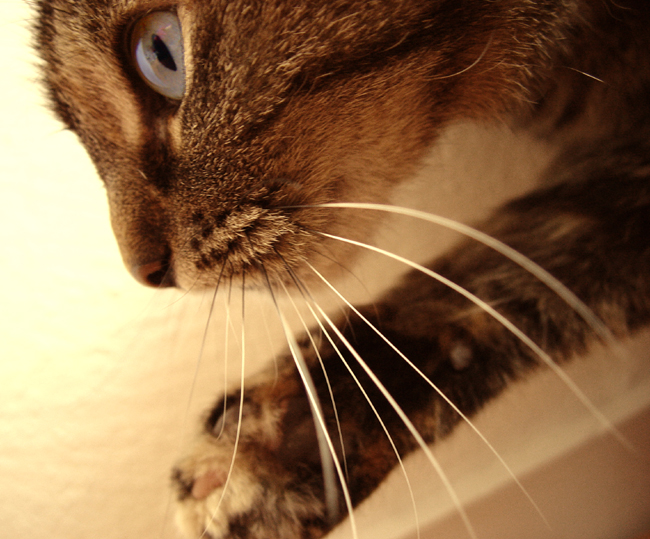By: Hester-Lynne Murdoch
A domesticated cat's vibrissae are known as whiskers
Description:
The long, stiff, specialized hairs, on a cat's face and body, called Vibrissae; also known as whiskers or tactile hairs.
Description:
They differ from the cat’s normal body hair in that they are long, tapering, stiff yet flexible hairs. They are double and even three times the thickness of a normal cat hair and many times the length; they can grow to be extremely long.
The most obvious will be found in horizontal rows on the puffy area known as the whisker pad on the cheeks of a cats face, mainly in the area between the corner of a cat’s mouth and the outer corner of the nose.
Yet there are many more all around the face, in the area of the chin, and the eyebrows, also on the body especially around the front-, the hind legs and feet, although they are sometimes shorter.
The whisker itself does not have nerves (all hair and nails have no feeling, the feeling comes from the follicle it grows from or the nail bed it touches). Each whisker is rooted deeply in a follicle, surrounded by a highly developed sheath of muscle tissue, rich in nerves and sensory cells, sealed by a capsule of blood, called a blood sinus. The muscle is used to move the whisker in any direction to optimise use. The nerves connect the whisker to a large section of the cat’s brain especially reserved for processing the nerve impulses coming from the whiskers. Touching the whisker, causes it to move, this compresses the blood in the sinus to the opposite side. The blood amplifies the movement, thus allowing the sensor cells to detect the most miniscule of movement.
All this: because the whiskers are one of the cat’s main survival tools.
Vibrissae of a tiger at Chester Zoo
Their function:
Judge size
When a cat’s facial whiskers are “put up” and alert, they are roughly equal to the width of the body. If you observe a cat testing an opening, it will stick its head in and out of the opening and then only proceed. What has happened is it was measuring the size of the hole compared to its body size and width. The cat has learnt with experience how much pressure on the sensor cells in the hair follicle equals a safe passage.
Navigation
A cat has excellent sight many times that of man, but still it cannot see when it is completely dark, here its whiskers aid the cat to feel its way around. During a very dark night or if the animal is in an enclosed area (man made like a tunnel or natural for example a cave) where there is no or very little light the cat will rely on air currents and air compression to navigate. Its whiskers can detect the slightest movement of air, air moves in distinct ways around barriers, and as the cat nears an object, the air compresses and expands when it moves away; the cat has learnt to read these signals.
Mood Communication
Whiskers are a good indication of a cat’s state of mind:
A defensive, aggressive, angry cat will pull his whiskers back towards its body
A very happy, curious cat will push its whiskers forward.
An alert, interested and curious cat will “Put-up” or extended its whiskers in a full circle around the face:
An excited, animated animal will push its whiskers to point forward.
A resting cat that is content will relax its whiskers against its face.
A bit more:
- Similar to normal hair they do fall out naturally and re-grow.
- Cats whiskers are like human finger prints, the individual aligning is unique to each cat.
- The breed of cat called the “Sphinx”, often have no whiskers.
Why you shouldn't cut or trim a cat's whiskers
- Clipping, cutting or otherwise removing the cat’s whiskers is cruel; it is likened to removing one of our senses, e.g. Sight (to be blinded), smell (to lose your sense of smell), touch (to not be able to feel), taste (not to be able to taste anything) or hear (to be deaf), in a cats case they have the special sense of detection; the work of the whiskers.
- You will be depriving the animal of one of his means of communication (see mood communication above).
- You will be putting the animals life in danger, it will not be able to discern openings accurately and runs the danger of getting stuck, with possible fatal consequences.
Written in loving memory of all those wonderful felines that purred their way through my life.
Pictures with thanks from Wikipedia.
Please feel free to use this article – provided it is published in its entirety, with my resource box and a “live” linkable link to http://catsfelinestameandwild-hester-lynne.blogspot.com/
Hester-Lynne Murdoch: I have been involved with cats for at least 45 years. I have bred them (long haired and short-haired breeds) and showed them with a good deal of success, but my most proud achievement is moving to a farm overrun with feral cats. I set out to tame them to with the purpose to neuter and spay each and every one to stop the uncontrolled breeding in the kindest way. I am happy to say the job (76 cats) was done in a time of 2 months and 4 days. Today no more cats are born there and as the older ones pass on, the population is becoming more and more acceptable.
One more thing, I raised a



No comments:
Post a Comment